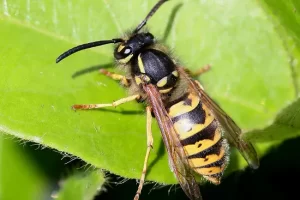Wasps

Various wasp nests
Paper pulp type wasp colony on maple tree, photographed near Maple Lake in Cook County, Illinois in October 2008The type of nest produced by wasps can depend on the species and location. Many social wasps produce paper pulp nests on trees, in attics, holes in the ground or other such sheltered areas with access to the outdoors. By contrast solitary wasps are generally parasitic or predatory and only the latter build nests at all. Unlike honey bees, wasps have no wax producing glands. Many instead create a paper-like substance primarily from wood pulp. Wood fibers are gathered locally from weathered wood, softened by chewing and mixing with saliva. The pulp is then used to make combs with cells for brood rearing. More commonly, nests are simply burrows excavated in a substrate (usually the soil, but also plant stems), or, if constructed, they are constructed from mud.
Solitary wasps
The nesting habits of solitary wasps are more diverse than those of social wasps. Mud daubers and pollen wasps construct mud cells in sheltered places typically on the side of walls. Potter wasps similarly build vase-like nests from mud, often with multiple cells, attached to the twigs of trees or against walls. Most other predatory wasps burrow into soil or into plant stems, and a few do not build nests at all and prefer naturally occurring cavities, such as small holes in wood. A single egg is laid in each cell, which is sealed thereafter, so there is no interaction between the larvae and the adults, unlike in social wasps. In some species, male eggs are selectively placed on smaller prey, leading to males being generally smaller than females.
Social wasps
The nests of some social wasps, such as hornets, are first constructed by the queen and reach about the size of a walnut before sterile female workers take over construction. The queen initially starts the nest by making a single layer or canopy and working outwards until she reaches the edges of the cavity.
Beneath the canopy she constructs a stalk to which she can attach several cells; these cells are where the first eggs will be laid. The queen then continues to work outwards to the edges of the cavity after which she adds another tier. This process is repeated, each time adding a new tier until eventually enough female workers have been born and matured to take over construction of the nest leaving the queen to focus on reproduction. For this reason, the size of a nest is generally a good indicator of approximately how many female workers there are in the colony. Social wasp colonies often have populations exceeding several thousand female workers and at least one queen. Polistes and some related types of paper wasp do not construct their nests in tiers but rather in flat single combs.
Social wasp reproductive cycle (temperate species only)
Wasps do not reproduce via mating flights like bees. Instead social wasps reproduce between a fertile queen and male wasp; in some cases queens may be fertilized by the sperm of several males. After successfully mating, the male’s sperm cells are stored in a tightly packed ball inside the queen. The sperm cells are kept stored in a dormant state until they are needed the following spring. At a certain time of the year (often around autumn), the bulk of the wasp colony dies away, leaving only the young mated queens alive. During this time they leave the nest and find a suitable area to hibernate for the winter.

